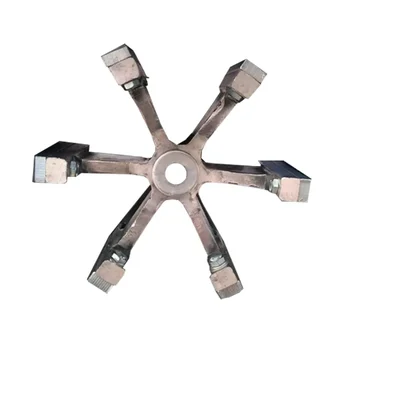- Farm & Garden
- Pumps & Motors
- Food Processing
- Workshop, DIY & MRO

Brand: Generic ( Made in India )
Beater Blade for 1 HP Domestic Flour Mill Machine
SKU: TI-BB-39896 Delivery By: Dec 19 - Dec 21
Delivery By: Dec 19 - Dec 21 




MRP : ₹950 ₹885
7% OFF!
 Delivery By: Dec 19 - Dec 21
Delivery By: Dec 19 - Dec 21 
Easy Return
& Refund
& Refund

Quality
Assurance
Assurance

Trusted
Delivery
Delivery

After Sales
Assistance
Assistance

Buyer
Protection
Protection
₹885 (Including GST)
MRP : ₹950
7% OFF!
Get Extra ₹13 OFF on Prepaid Orders
QTY :
-
1
+
Short Description
Beater blade for domestic Flour mill machine
For 1 HP flour mill
Country of origin: India
Specifications
- Brand: Generic ( Made in India )
- Weight (Approx.) : 2 kg
- Material - Aluminium
- Quantity : 1
- Blade - 6
Description
This Beater Blade is a fundamental and critical replacement component for your 1 HP domestic flour mill (Atta Chakki). It is the primary working part responsible for efficiently grinding various dry grains into fine flour for household use. When your flour mill's performance declines, or the flour consistency changes, a worn-out beater blade is often the culprit, making this replacement essential for restoring optimal grinding capability.
Features
:- Core Grinding Component: This blade serves as the central pulverizing tool within the flour mill's grinding chamber. It directly impacts and crushes grains as it rotates at high speed, turning them into flour.
- Durable Construction: Typically manufactured from high-grade, hardened steel or a robust metal alloy, this blade is built to withstand the immense forces and abrasion involved in grinding hard grains like wheat, rice, maize, and pulses. Its strength ensures a long operational life and consistent performance.
- Precision Engineering: Each beater blade is precisely engineered and balanced to ensure smooth rotation and minimal vibration during operation. This precision fit is crucial for efficient grinding, preventing undue stress on the motor, and extending the overall lifespan of your flour mill.
- Efficient Grinding Action: The design of the blade (which may vary in number of sides/projections, but always optimized for impact) creates a powerful grinding action that effectively breaks down grain kernels. A sharp and intact blade is key to achieving a fine and uniform flour consistency.
- Versatile Application: While primarily used for common food grains, a high-quality beater blade is versatile enough to handle a range of dry, non-oily materials commonly ground in a domestic setting.
- Restores Performance: Replacing a worn, dull, or damaged beater blade can dramatically improve your flour mill's efficiency, speed of grinding, and the fineness of the flour produced, making your home milling experience much more effective.
- Easy Replacement: Designed for straightforward installation, allowing home users to replace their old blade with minimal tools and effort, getting their atta chakki back to peak performance quickly.
- Essential Maintenance Part: This is an indispensable spare part for any domestic flour mill owner, crucial for routine maintenance and ensuring continuous access to fresh, home-ground flour.
Applications
:The primary application of the beater blade in a 1 HP domestic flour mill is to pulverize dry grains into fine flour for household consumption. More specifically, its applications include:
Grain Pulverization: This is its core application. As the motor rotates the blade at high RPMs, it impacts, crushes, and grinds various dry grains (such as wheat, rice, maize/corn, jowar/sorghum, bajra/millet, and dry pulses/dals) against the inner walls of the grinding chamber and the attached sieve (jali).
Flour Consistency and Fineness: The design and sharpness of the beater blade, in conjunction with the selected sieve, directly determine the fineness and uniformity of the resulting flour. Its application ensures that grains are broken down into particles small enough to pass through the desired mesh size.
Efficiency and Speed of Grinding: A well-designed and sharp beater blade ensures efficient energy transfer from the motor to the grains, leading to faster grinding times and less strain on the 1 HP motor. This is crucial for optimizing the mill's throughput in a domestic setting.
Maintaining Mill Performance: As a consumable part, the beater blade's application extends to routine maintenance. Replacing a worn, dull, or damaged blade with a new one is essential to restore the mill's original grinding efficiency and prevent substandard flour production.
Versatile Processing: Beyond common cereals, the beater blade is applied in a domestic mill for grinding a variety of other dry, non-oily food items that require pulverization, such as dried spices or other hard food ingredients.
Usage
:he beater blade is the central, active component inside a 1 HP domestic flour mill (Atta Chakki). Its key usage is fundamental to the entire flour milling process and its efficiency:
Primary Pulverization of Grains: This is the most crucial usage. The beater blade, spinning at high speed, directly impacts and crushes dry grains (like wheat, rice, maize, etc.) into fine powder (flour) against the mill's internal walls and sieve. It's the direct agent of transformation from whole grain to flour.
Determining Flour Fineness and Consistency: The design, sharpness, and integrity of the beater blade, in conjunction with the chosen sieve, dictate how fine and uniform the resulting flour will be. A well-performing blade ensures consistent particle size, which is vital for quality baking and cooking.
Ensuring Grinding Efficiency and Speed: A sharp and correctly balanced beater blade allows the mill to process grains quickly and efficiently. Its optimal usage ensures that the 1 HP motor works effectively without undue strain, leading to faster grinding times and less energy consumption.
Maintaining Mill Performance and Longevity: As a wear-and-tear part, the key usage also involves its timely replacement. When the blade becomes dull or damaged, replacing it ensures the mill continues to operate at peak efficiency, preventing substandard flour output and reducing stress on the motor and other components, thereby prolonging the mill's lifespan.

Select attribute









